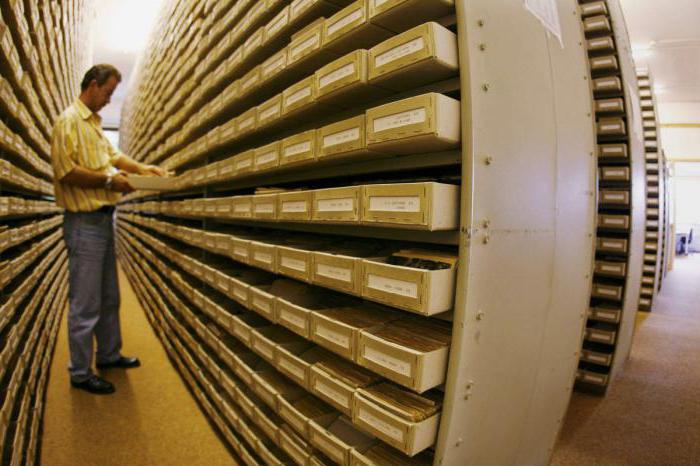The archive may exist as a separate structural unit of a particular organization or be an integral part of the office management service. It depends on the volume of the existing workflow.
How to organize it
Creating an archive of any enterprise or organization requires the implementation of a set of specific measures:
- You will need to choose a suitable storage room for storing documents and properly equip it.
- Care should be taken to create conditions that are consistent with regulatory.
- It is necessary to equip it from a technical point of view - to purchase and install the necessary equipment for the archive.
- A procedure for organizing the archiving of all necessary documents must be organized in the repository.
- The regulatory framework of this unit should be developed and approved.
The implementation of these measures ensures the preservation of archival documents and maintaining them in the required condition.
Who is the archivist?
And what are the requirements for those employees who will be involved in organizing the archive and further storing documents? Can the positions of their custodian and, for example, secretary or clerk be combined?
An archivist is a specialist whose tasks include organizing archival activities. For the safety of the documents entrusted to him, he is fully responsible. His work is impossible without undergoing a specific briefing or even (if necessary) an internship at the State Archive.
Its functions can be transferred to another employee, which is part-time work. As a rule, the duties of the archivist are assigned to an individual employee in the event that the volume of documents handed over for storage is sufficiently large. In large organizations, the staffing table provides a separate position for this purpose. In the same case, a job description is usually drawn up indicating the types of work assigned to the archivist, as well as his duties and rights.
The main thing is order
Cases are transferred to the organization’s archive according to a specially designed schedule. Its compilation should be coordinated with the heads of each of the structural units to which documents are to be transferred, and also approved by the archivist. Since working documents are not only stored in the archive, but are also periodically used, the procedure for their issuance (if necessary) should be determined according to the submitted applications of the organization’s employees, as well as third-party interested parties.
The issuance of documents should be noted in certain books of registration. To complete the process, there are requirements-orders, acts on the transfer of cases for the temporary use procedure to outside organizations (among others, these may include prosecution authorities and the court). Documents are issued for a period of up to one month to their own employees and up to three months to representatives of third parties.
Basic rules for the operation of archives of organizations
The archive, like any structural unit, operates on the basis of a special Regulation approved by the management. His employees in their work adhere to their own job descriptions. The Regulation adopted by the enterprise establishes the basic rules for the operation of archives of organizations (status, functionality, measure of rights and responsibilities and the composition of the necessary documentation). Its main tasks include:
- Complete the archive with documents, the composition of which is listed in a separate section of this Regulation.
- Keep records of materials and ensure their safety.
- To develop a scientific reference apparatus to the available documents.
- Allow to conduct the procedure for using the material stored in the archive.
If the organization has documents that may be related to the Archival Fund of the Russian Federation, then preparing and transferring them for permanent storage to the state repository is one of the external tasks of this structural unit.
Its functionality
The functions of the archive systematically follow from the tasks assigned to it. The main ones are the following:

- Keep lists of sources of own acquisition, that is, organizations or structural divisions.
- Receive documents from them in an ordered form for storage.
- Take into account the accepted materials and ensure their complete safety.
- Generate and maintain a reference system related to archival documentation.
- Maintain the informational nature of the leadership and all structural units of your organization.
- Organize the issuance and use of documentation according to the requests of individuals and third-party organizations, take into account and analyze the process of this use.
- To prepare extracts and official answers to inquiries of citizens of a social and legal nature.
- Carry out measures to assess the value of a document, organize the procedure for transferring them for permanent storage to the municipal or state archive (in the case when this organization is one of the sources for completing the above archives).
- Check the correctness of the design and formation of archival files in the sources of acquisition - both in their own structural divisions and in other organizations.
- To organize work on the business nomenclature of the enterprise.
- Provide practical and methodological assistance in working with documentation to each structural unit.
- Participate in the development of archiving and management documentation.
- To take part in events held with the aim of improving the qualifications of archival workers and employees in positions related to the documentation support of management.

Where to place it
Let us now consider what are the requirements for the placement of the archive. The most important thing to keep in mind is that it is by no means permitted to place it in dilapidated buildings, wooden structures, buildings in which not only the main rooms, but also attics with basements, as well as in buildings, can be damp. having stove heating.
If the building as a whole is adapted to the storage of paper documentation, then an isolated room is intended for the archive.
If your organization plans to create your own archive in the near future, below you have the opportunity to familiarize yourself with the list of requirements that must be taken into account in the preparation process. So, what are the basic requirements for the archive, the task of which is to carefully and reliably save all the necessary documentation?
List of what is required to be available
- Archive.
- The room intended for the reception of documents, their temporary storage, as well as acclimatization.
- The room in which the documents will be used.
- Work room (or rooms) for employees.
When there is not enough space ...
In the case when the area of the archive room does not allow the assignment of several rooms for it, the allocated single space should be divided into zones divided by partitions. The main requirement that must be strictly observed in this case is isolated from each other places for storing documents and working with them.
A separate room or a building specially used and adapted as a document repository, used as an archive, must be removed from objects that pose a danger in terms of the possibility of fire. As an example of such can be called parking lots, gas stations or garages. In the immediate vicinity of the building or the premises of the archive should not be objects that serve as sources of air pollution.
Ideally, archives should always be located in a separate building designed exclusively for this purpose, built in compliance with all necessary norms and rules. But, unfortunately, reality dictates its conditions, and in most organizations documents are stored in an existing room, converted and adapted for these purposes.
What the rules say
We will get acquainted with the regulatory requirements for the buildings and premises of the archive. They are as follows:
- The building where the future repository is supposed to be located is obligated to be among the administrative ones. It is strictly forbidden to place the archive where catering services, food warehouses are located, substances from the category of fire hazardous and aggressive are stored, and appropriate chemical technologies are applied.
- Its placement in an unheated room and where sanitary and hygienic requirements are not observed is excluded. The inadmissibility of the dilapidation of the archival building has already been said above.
- It is especially important to comply with the fire requirements for the archive premises. Its safety for possible fire is one of the most basic conditions for reliable storage of documentation. In January 2009, the Ministry of Culture of Russia, by its order No. 3, approved a number of regulatory requirements set forth in the special Fire Safety Rules of the state and municipal archives of the Russian Federation. When arranging a document repository, these regulations must be strictly observed.
- The construction of the building must ensure that it cannot be flooded. The room must have an emergency exit. In no case is the passage of a main pipeline (water-carrying or gas) through it.

Is it possible to place the archive in the basement?
It is highly not recommended that archival storage be placed in the basement, upper floors or re-equipment as such an attic space.
In case of urgent need, exceptions to this rule are possible. They are taken when the basement is dry and well heated, equipped with artificial ventilation, capable of providing two or three times air exchange within an hour. An archive on the upper floors or in the attic is possible only if the appropriate temperature and humidity conditions are ensured.
Very important are the requirements for placing the archive with respect to the wiring device. It must be closed with sealed receptacles. Cords of portable electrical equipment are supplied with rubber insulation. It is impossible to have indoors storage of general or floor breakers.
As building materials for finishing archival storage, dust-free and non-aggressive materials are chosen. The fire extinguishing system must be equipped with neutral means, safe for documents. It is not allowed to use fire in the storehouse, turn on heating devices or place foreign objects.
To summarize
After bringing the selected area into compliance with all the above requirements for the archive premises, the final decision is made on the suitability or unsuitability for use. It is possible to make such a decision after being checked by the sanitary epidemiological station and state fire control. The archive can be placed where it is planned, only after the procedure for passing a detailed examination.
Its purpose is to clarify the fire resistance of the room and determine the appropriate degree, check the main structures for durability, verify the strength of the floors between floors in terms of the potential load (archive equipment and the weight of the stored documentation), check the presence and current status of ventilation and heating systems.
The audit involves representatives of the organization itself (usually employees of the future archive) and employees of all relevant services - construction, fire, security, etc. The results of the examination are reflected in the preparation of the final act.